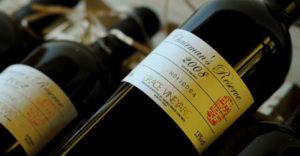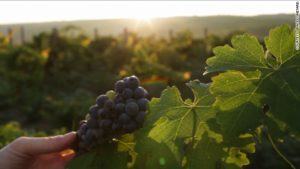In Vino Veritas?

Climate change may be bad news for the chateaux of Bordeaux, but Chinese vineyards are ready to lead a new world order in wine.
While ancient Romans found philosophical truth in wine, modern society has found in wine truth of a different sort: scientific evidence of climate change. Researchers have tied dramatic shifts in the harvesting season of grapes over the past 30 years with the warmer, dryer summers that have resulted from climate change.[1] This sudden divergence from long-standing growing patterns will shake up the wine industry: up to 73% of land in some of the top wine producing regions may be unsuitable for wine production as early as 2050.[2] On the other hand, the changing climate is expected to make new regions—such as China—increasingly suitable for wine production.[3]
Grace Vineyard
One company poised to take advantage of the shifting wine industry is Grac e Vineyard. Located in Shanxi province, it has been in operation since 1997 and is regarded as one of the top wineries in China.[4] As an early mover in Chinese wine production, Grace is well-positioned to expand production in a world that demands more Chinese wine.
e Vineyard. Located in Shanxi province, it has been in operation since 1997 and is regarded as one of the top wineries in China.[4] As an early mover in Chinese wine production, Grace is well-positioned to expand production in a world that demands more Chinese wine.
While Grace stands to benefit from competitors weakened by climate change, it also will be subject to deleterious effects of its own. Wine grapes are extremely sensitive to temperature, humidity, and soil conditions. As climate change affects these factors, Grace will have to adjust its varietal mix to find grapes that will thrive under new or changing conditions. Luckily for Grace, unlike wineries with long traditions of grapes cultivation, Grace already has had the experience of developing its mix of grape varietals through trial and error to find grapes appropriate for the Shanxi terroir.
Building on its varietal sourcing experience, Grace should continue to plant a wide mix of varietals, while also keeping careful track of variations in soil conditions and seeking new land for vineyard expansion with the kind of soil that will produce optimal grapes given changing climate conditions. Grace can also hedge against unpredictable growing seasons by producing blends of multiple types of grapes, since different grapes are affected differently by climate conditions.[5]
Human Risks
Climate change may also put Grace’s relationship with local farmers at risk. Grace owns some vineyards, but also has cooperative agreements with local farmers who produce additional grape stock on farmer-owned land.[6] Farmers receive a minimum payment from Grace based on quantity produced, as well as bonuses for achieving quality targets.[7]
 Increasing climate volatility will lead to less consistent grape quality. Scientists have found that changes in temperature and humidity have significant effects on the sugar and acidity levels of Cabernet Sauvignon and Merlot, which accounted for 39% and 29% of Grace’s grape production in 2012 respectively.[8] This is problematic for Grace not only because its inputs are at risk, but because its model depends so much on keeping the farmers satisfied with their incentives. Without the cooperation of farmers, Grace’s wine production would be severely limited. As arable land and water decrease, farmers will likely be offered increasingly large incentives to focus on food production. Grace needs to ensure that it offers farmers competitive incentives for grape production, even if the frequency of climate change-induced droughts or heatwaves increase and adversely affect grape quality. Grace might consider incentives tied to continued partnership in order to retain its farmer partners.
Increasing climate volatility will lead to less consistent grape quality. Scientists have found that changes in temperature and humidity have significant effects on the sugar and acidity levels of Cabernet Sauvignon and Merlot, which accounted for 39% and 29% of Grace’s grape production in 2012 respectively.[8] This is problematic for Grace not only because its inputs are at risk, but because its model depends so much on keeping the farmers satisfied with their incentives. Without the cooperation of farmers, Grace’s wine production would be severely limited. As arable land and water decrease, farmers will likely be offered increasingly large incentives to focus on food production. Grace needs to ensure that it offers farmers competitive incentives for grape production, even if the frequency of climate change-induced droughts or heatwaves increase and adversely affect grape quality. Grace might consider incentives tied to continued partnership in order to retain its farmer partners.
Not Such Bad News After All?
While climate change will add variability and uncertainty into the already temperamental wine industry, it will also provide opportunities for relative newcomers like Grace Vineyards to achieve global recognition. Now is the time for Grace to prepare for a world in which China is the new cultural center of the wine world.
Word Count: 797
[1] Michael Cabbage and Leslie McCarthy, “Climate Change is Shifting Wine Grape Harvests in France and Switzerland,” NASA Global Climate Change website, March 21, 2106, http://climate.nasa.gov/news/2418/climate-change-is-shifting-wine-grape-harvests-in-france-and-switzerland/
[2] Marc Lallanilla, “Will Global Warming Crush the Wine Industry?” LiveScience, April 9, 2013, http://www.livescience.com/28577-wine-global-warming.html; Lee Hannah, Patrick R. Roehrdanz, Makihiko Ikegami, Anderson V. Shepard, M. Rebecca Shaw, Gary Tabor, Lu Zhi, Pablo A. Marquet, and Robert J. Hijmans, “Climate Change, Wine, and Conversation,” Proceedings of the National Academy of Sciences of the United States of America 110(17), April 23, 2013, http://www.pnas.org/content/110/17/6907.full.pdf.
[3] Michelle Renee Mozell and Liz Thach, “The Impact of Climate Change on the Global Wine Industry: Challenges & Solutions,” Wine Economics and Policy 3(2) December 2014, p. 81-89 http://www.sciencedirect.com/science/article/pii/S2212977414000222
[4] Grace Vineyard Website, http://en.grace-vineyard.com/about.html#box_brand_rim
[5] Gregory V. Jones and Karl-Heinz Storchmann, “Wine Market Prices and Investment under Uncertainty: An Econometric Model for Bordeaux Crus Classes,” Agricultural Economics 26 (2011) p. 115-133 http://ageconsearch.umn.edu/bitstream/177466/2/agec2001v026i002a002.pdf
[6] William C. Kirby, Michael Shih-Ta Chen, and Keith Chi-Ho Wong, “Appellation Shanxi: Grace Vineyard” HBS No. 309-375 (Boston: Harvard Business School Publishing, 2013).
[7] Kirby et al., p. 5.
[8] Gregory V. Jones and Karl-Heinz Storchmann, “Wine Market Prices and Investment under Uncertainty: An Econometric Model for Bordeaux Crus Classes,” Agricultural Economics 26 (2011) p. 115-133 http://ageconsearch.umn.edu/bitstream/177466/2/agec2001v026i002a002.pdf
Photos from: http://www.timeout.com/travel/features/1293/inside-chinas-biggest-winery and http://www.cnn.com/2014/09/27/world/asia/china-wine-kristie-lu-stout/



Shifting climate patterns will clearly leave agricultural winners and losers as different areas become more acceptable for certain grape varietals to be harvested. Are there any other locations with a more traditional history of grape production that can use similar efficiencies of moving away from single varietal bottling in favor of a blend that can be adapted based on that season’s yield? The effect of oceans rising cannot be ignored in this conversation as well as this will impact areas that will continue to have an acceptable climate, but could be effected by costal flooding. Areas such as Bordeaux, Portugal, New Zealand, and Australia are particularly at risk [1]. Rising sea levels could also increase the risk for earthquakes in certain areas which would impact the growing regions of Oregon, Washington, British Columbia, Chile, Argentina, and New Zealand [2]. All of these areas are in danger with climate change, and it would be a smart idea for unaffected areas to start diversifying their production and looking into similar constructions of blend varieties in order to build a brand that can weather the oncoming storm.
1 Michelle Renée Mozell, Liz Thach, “The impact of climate change on the global wine industry: Challenges & solutions,” Science Direct , Vol 3:2, December 2014, http://www.sciencedirect.com/science/article/pii/S2212977414000222 accessed November 6, 2016.
2 Ibid.
Interesting article! Do you foresee a geographic shift in the future, where “Washington or British Columbia will become the new Napa and Central China the new Chile” [1]? Or will consumers simply change their preferences for other grape varieties? I’m also interested to know how the “old world” vineyards are preparing for the risks of climate change. The affluent Chinese consumers and investors are one of the major buyers of Bordeaux wines like Lafite and Margaux, and Latour – driving up the prices for these wines year over year [2]. So with an increasing foreign consumer demand for these old world wines combined with the risk of global warming, will this push the prices and values of French wines even higher? Or will the Chinese consumers and investors revert their attention back to their own vineyards for the hope of cultivating them into the next Bordeaux?
[1] https://www.sciencedaily.com/releases/2016/03/160321123549.htm
[2] http://blogs.wsj.com/chinarealtime/2010/09/17/why-the-chinese-love-lafite/